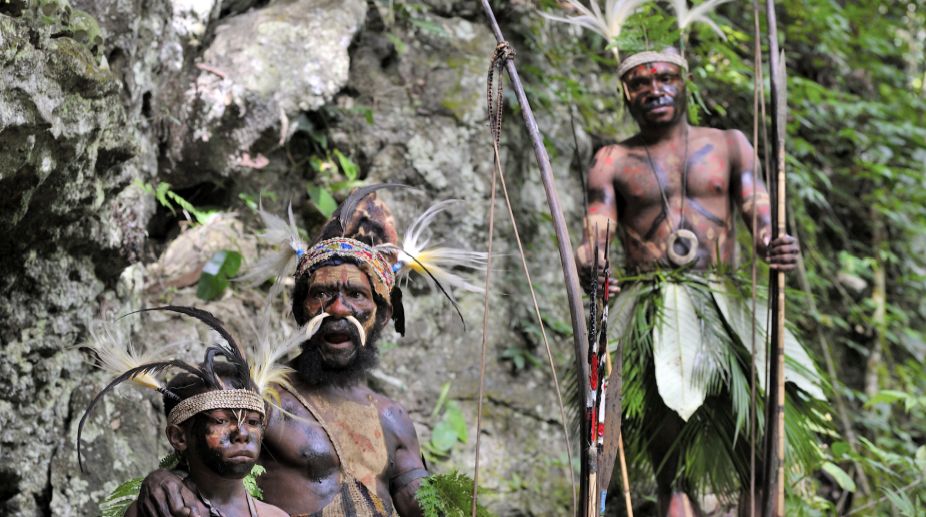PM announces 12-step programme to enhance partnership with Pacific nations
Modi slams barriers in supply chains; announces 12-step programme to enhance partnership with Pacific Island nations

Representational image (Photo: Getty Images)
In Down the Mighty River with Steve Backshall, the adventurer and naturalist took a journey through New Guinea, the world’s second largest island.
As he travelled along the Baliem River for the new documentary series, through some of the densest jungle on the planet, Backshall visited the Dani people, which the BBC described as an “ancient tribe”.
Advertisement
I spent two years living with groups not far from the Dani, and was disappointed to hear this sort of language still being used. T
Advertisement
his distorted perspective perpetuates the myth of the “living fossil” or the “backwards tribe”. After all, what exactly is an “ancient tribe”? Surely, by definition, an ancient tribe is either really, really old, or really, really dead. The Dani are neither. Nor are they “backward”.
The 25,000 or so Dani people scattered across the Baliem Valley are very much alive and well, prospering in a challenging region despite being faced with land dispossession from mining, military control from Indonesia, and the occasional film crew from “the West”.
Indeed, the Dani have featured in several TV and film documentaries over the years. The first of these, Dead Birds, made in the early 1960s by anthropologist-filmmaker Robert Gardner, followed two males as they went about their everyday business. Back then, the Dani were a model of “tribal culture” representing what was fast becoming an elusive example of “stone-age man”.
They used stone tools, practised gift exchange and fought over territory.
Such practices were typical across the island of New Guinea, particularly in the vast central highlands.
Over 50,000 years of habitation, this almost impenetrable rainforest proved the ideal environment for developing permanent agriculture, complete with drainage canals.
The Dani themselves were only first “discovered” in 1938 when, completely by chance, a pilot flying overhead spotted their cultivated fields.
But they had long been part of a complex social network of exchange and interaction that reached across the island.
Even the government patrols and prospectors that once infested New Guinea were restricted to more accessible coastal regions, so the island’s rural inhabitants continued farming, trading and intermarrying across huge distances.
They live 1,600 metres above sea level in the heart of the Cyclops Mountains. By the time of “discovery”, the indigenous population had, politically, already been divided in two.
In 1828, European colonisers separated New Guinea in half, right down the 141st meridian.
By 1963 the western half was formally annexed to Indonesia, while the east became formally detached from Australia in 1975 to form the independent state of Papua New Guinea.
The Dani people are therefore governed ultimately from the Indonesian capital Jakarta, some 3,500km away, while an international border separates them from their kin in Papua New Guinea.
These culturally and historically linked groups have been fighting ever since to release West Papua from Indonesia.
The region’s cultural complexity has made it an ideal location for anthropologists and my own work has taken me to the Kutubu and Ok Tedi regions in Papua New Guinea.
In Ok Tedi, which lies just on the other side of the 141st meridian, my friends and hosts were very similar to the Dani people that Backshall met.
Like the Dani, they value the sal kambun (penis gourd) and bul bul (grass skirts) as symbols of identity, and they value the stone axe for its practical ability to outlive and outperform the modern alternatives sent to replace it — steel axes and knives.
The ritual amputation of digits is common across the island. As anthropologist Karl Heider recalls in his ethnographic examination of the Dani, close female relatives of males killed in warfare (not those who die from “natural” causes) “have their fingers chopped off”.
This is not unique to the Dani — in fact, digit/hand amputation was not unusual among men and women across the highland region before missionary intervention.
In one of his most memorable scenes, Backshall was invited to sleep alongside the smoke-dried remains of a legendary village elder.
Such mummification is actually quite rare across the highlands, even among the Dani, who according to Heider cremate the dead in a detailed and lengthy series of funerary rites. The practice is typically associated with the Anga language group in Papua New Guinea and likely spread eastwards to the Dani.
In recent years, the Dani have been affected by mining, tourism and ongoing attempts to “Indonesianise” their highland culture.
But perhaps the biggest threat of all comes from the military presence representing Indonesian interests in a resource-rich land with what they see as a “backwards” culture.
Like the colonialists who described the vast area of internal New Guinea as “uninhabited”, government bodies and multinationals still view rural landscapes as Terra nullius, “no one’s land”.
The illusion of “no one’s land” and “the ancient tribe” is not helpful to the amazing people who live there.
My friends in Ok Tedi and Kutubu are artists, school teachers, academics, gardeners, widows, businessmen and businesswomen.
And yet, everything they do remains tightly entwined by a rich, resilient and dynamic culture.
The writer is a senior lecturer in anthropology at the University of East Anglia, UK
The Independent
Advertisement